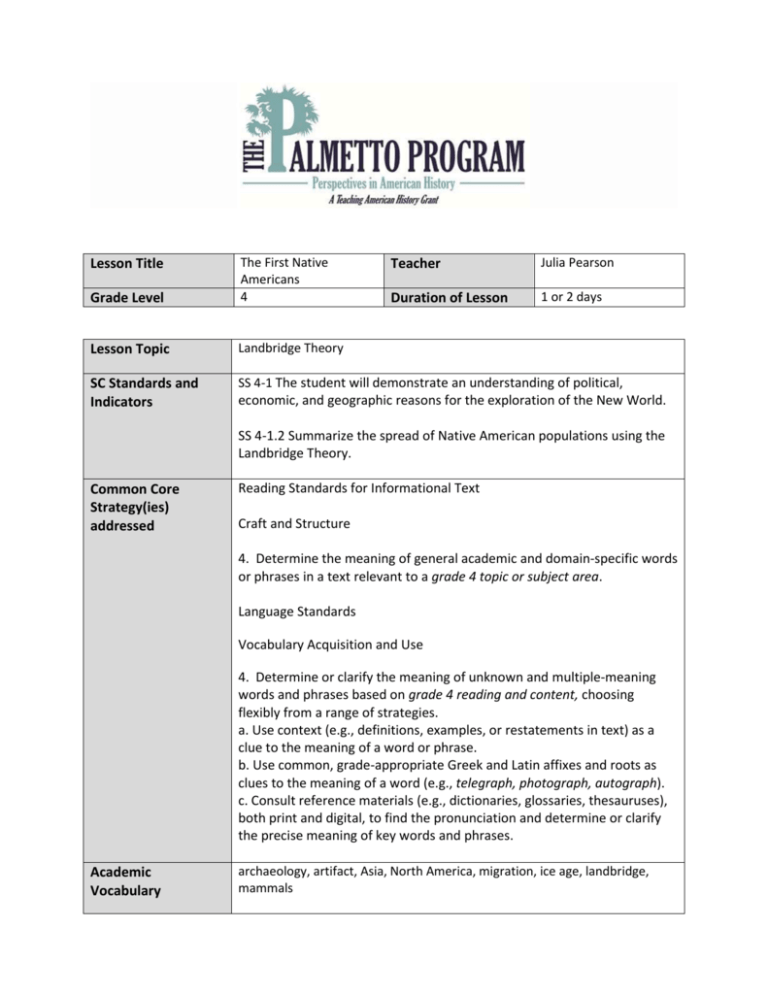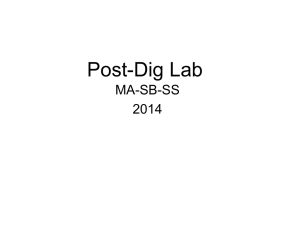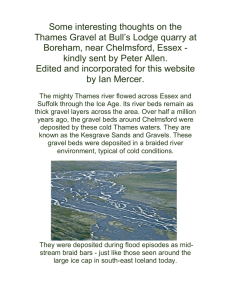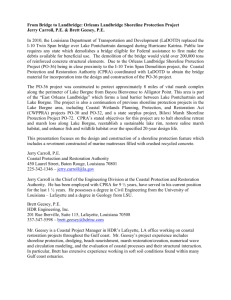Lesson Plan
advertisement

Grade Level The First Native Americans 4 Lesson Topic Landbridge Theory SC Standards and Indicators SS 4-1 The student will demonstrate an understanding of political, economic, and geographic reasons for the exploration of the New World. Lesson Title Teacher Julia Pearson Duration of Lesson 1 or 2 days SS 4-1.2 Summarize the spread of Native American populations using the Landbridge Theory. Common Core Strategy(ies) addressed Reading Standards for Informational Text Craft and Structure 4. Determine the meaning of general academic and domain-specific words or phrases in a text relevant to a grade 4 topic or subject area. Language Standards Vocabulary Acquisition and Use 4. Determine or clarify the meaning of unknown and multiple-meaning words and phrases based on grade 4 reading and content, choosing flexibly from a range of strategies. a. Use context (e.g., definitions, examples, or restatements in text) as a clue to the meaning of a word or phrase. b. Use common, grade-appropriate Greek and Latin affixes and roots as clues to the meaning of a word (e.g., telegraph, photograph, autograph). c. Consult reference materials (e.g., dictionaries, glossaries, thesauruses), both print and digital, to find the pronunciation and determine or clarify the precise meaning of key words and phrases. Academic Vocabulary archaeology, artifact, Asia, North America, migration, ice age, landbridge, mammals Lesson Materials Needed (attached at end of lesson) clear or translucent plastic shoe boxes playground sand aquarium gravel pennies plastic spoons pictures of Native American artifacts map of Pacific region Content Narrative According to the Landbridge theory, Native Americans migrated from Asia to North America across the land bridge during the Ice Age. During this time period, low temperatures caused the level of water in the ocean to drop. Because the frozen water caused the level of the oceans to drop, the land that once was under water became exposed, creating a long land bridge that connected North America to Asia. By following herds of animals, hunter-gatherer people may have crossed this land bridge from Asia into North American and then continued across North America and into South America. The student should be able to create and recognize a map of the Landbridge theory. (What is the background information that needs to be taught to understand the context of the lesson? Be sure to include necessary citations) South Carolina State Department of Education Lesson Set Content Objective(s) The student will use a map to trace and label the migration of early Native Americans from Asia to North America. Literacy Objective(s) The student will learn key vocabulary associated with the Landbridge theory. Lesson Importance It is important for students to understand how what we call Native Americans came to North America, and that Native Americans were here long before the first European explorers and settlers. Connections to prior and future learning Students will learn about lifestyles, etc. of Native Americans in different geographic regions of North America. Anticipatory Set/ Hook (Engage) See Materials Needed for Lesson (end of lesson) for archaeology and artifact activity instructions for teacher. Define for students vocabulary words: archaeology, artifact “Archaeology” Activity: Give one box to two students or one per group. Tell students to use plastic spoons and dig in the box to remove aquarium gravel from sand. (Encourage hasty, messy digging.) Take those boxes up and give a second box. This time tell students to very carefully lift aquarium gravel from sand. Lift boxes above students’ heads for them to observe how the layer on the bottom of the first box was disturbed, but the layer on the bottom of the second box remained intact. “Artifact” Activity: Give student groups an envelope containing artifact pieces. Allow a few minutes for them to put pieces back together. Discuss how archaeologists must work very carefully to remove artifacts from sites. Optional: Show students images from well-known archaeological sites around the world. Skill Development Initial “explain” portion of the lesson. Introduce vocabulary, explain/demonstrate/model the skill required for the literacy objective, introduce content components. The content portion is only a brief introduction; the bulk of the student learning will take place during the guided practice activity. Informally assess students’ knowledge of the location of Asia and North Introduce content America. Use a world map to teach locations as necessary. components Introduce vocabulary words: ice age, landbridge, mammals, migration “I do” Skill from objective introduce/explain/model Give a short narrative on the ice age and formation of the landbridge between Asia and North America. Include how early humans were huntergatherers and followed migrating large mammals across the landbridge. (Use SC State Dept. of Ed. Support Documents.) Guided Practice This is the inquiry portion of the lesson, student-centered & often cooperative learning strategies used, teacher acting as facilitator, also known as Explore. Provide students with an outline map of the northern Pacific region, including “We do” Asia and North America. Have them label where the landbridge would have Activity Description Include student “explore” been located. As you orally provide landmarks have students trace a line from Asia into North America including across North America and into South components and opportunities for them to America. explain their learning. Checking for Understanding“Informal” Assessment Ask several questions concerning locations of Asia, North America, and landbridge and why early Native Americans ended up in North America. Students may respond via whiteboards or whatever system works in your classroom. Closure Teacher will re-visit content and answer students’ questions developed during the Guided Practice component. Summarize the lesson, clarify content, and revisit content and literacy objectives. Answer any questions students may still have. Content Solidified Independent Practice “You Do” Students write a paragraph explaining how early Native Americans came to North America. Give key words students must use in their writing: Asia, North America, ice age, landbridge, and migrate. Summative/ “Formal” Assessment Assessment Use paragraph for assessment and/or include several questions in final Native Americans assessment. Differentiation During Lesson Students may check and help partners with landbridge theory map. Assessment Pair higher ability writers with those of lower ability to help organize their writing. Reflection Lesson Reflection (What went well in the lesson? What might you do differently the next time you teach it? Evaluate the success of the lesson) My students enjoyed this lesson, especially the Lesson Set portion. Though the content knowledge for this indicator is brief, I felt it was important for them to understand the work needed to develop a theory of how early Native Americans came to North America. It also served as a link to further discussions of the next indicator on Native American regions. I had previously taught world and North American geography, but must continuously reinforce locations of places in the world, Europe, and United States. The next time I teach this lesson I think I will set up two “archaeology” boxes per group in my class. That way more students will be able to participate hands-on in the activity. On the final assessment I still had a number of students unable to locate Asia and North America correctly. As I said, knowledge of basic world geography is an on-going struggle. Materials Needed for Lesson Lesson Materials and “Archaeology” Activity: Handouts clear or translucent plastic shoe boxes playground sand aquarium gravel pennies You may use two boxes only for the whole class or set up two per student group. 1. Using pennies spell out the word “HELLO” in the bottom of each box. 2. Carefully scoop a layer of sand on top of the pennies. Add sand up to about 1/3 the height of the box. 3. Place some colorful aquarium gravel on top of the sand. Do not disturb until students complete the activity. “Artifact” Activity: Locate enough pictures of Native American artifacts for each group in your class. I searched Google Images and used pictures of 2 different pots, a mask, and a spear point. Print on cardstock, laminate, and cut into 4 or 5 “jigsaw” pieces. Place in envelopes.







